Diamonds grown in laboratories offer the beauty and durability of mined diamonds at a fraction of the price.
Ever wonder about karat, carat, and carrot? Three words that sound the same but have nothing to do with each other.
Did you ever notice how some diamonds sparkle a whole lot more than others? Well, it could be because of the way they were cut. A round diamond cut deeply causes the light to go out of the bottom - we call extreme cases of this Nail Heads. If the cutter shapes it too shallow - then the diamond can appear lifeless - we call them Fish Eyes.
A diamond cut to ideal proportions will return light like nothing else. No other gem can take light in and shoot it back at you like a diamond.
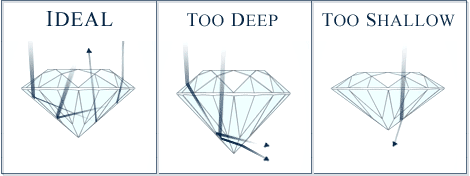
A couple of years ago we met Michael. He is a diamond cutter from New Jersey and is a master of his craft. When he stopped in the shop to show us what he could do, we bought one of his diamonds on the spot (Cliff never does that!). Since then we have introduced couples to his sparkle-fest diamonds. Laurie was so impressed, she wanted two of them for earrings!

There is one company that has been marketing ideal cut diamonds by showing customers the hearts and arrows visible in their diamonds using a viewing device. Te result is the heart shape patterns (above left) seen from the bottom of the diamond and the arrow patters (above right) seen from the top down.
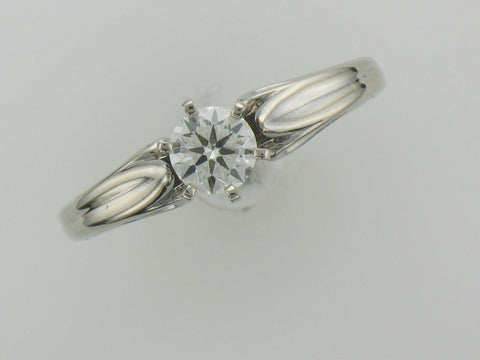
The diamonds Michael cuts are done so well, you do not even need a special viewing device to see the arrow patterns! The ring above is set with a .50 ct VS2 I diamond Michael cut and the one below features an .81 ct from Michael.

Ideal cut diamonds at Chimera Design - all the sparkle for less money!
Please come in and let us show you what a well cut diamond looks like -
we love to show off Michael's skills.
A big pink diamond is coming up for auction - it is expected to sell for 15 million or more. That is great - if your bank account can handle it.
If you WANT the coolness of colored diamonds without a movie star budget, we have some beautiful examples from Lotus Color in NYC. You can learn about how Lotus uses heat and radiation to turn natural diamonds a host of colors here: Learn About Colored Diamonds.
Lotus has the process down to an art form. Look at the bright, lovely colors in these pictures. These are all colored diamonds from Lotus. The colors will not fade and because they are natural diamonds, they return light and sparkle like no other gem on earth. (They only ones you have to be really careful with are the pink ones.)
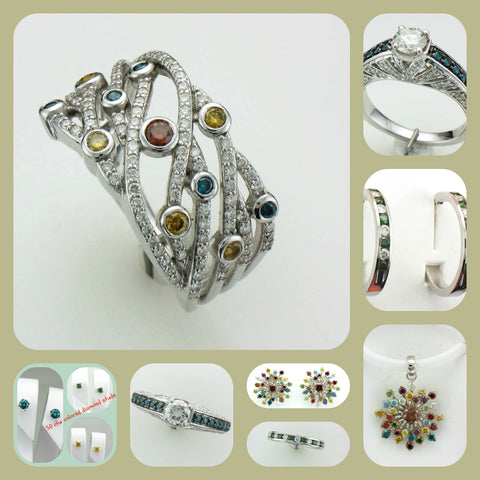
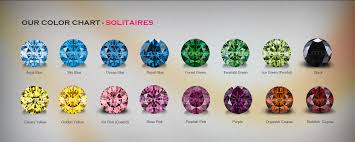
If you like stud earrings and you already own some white diamond studs, how about your color up your life with some colored diamond studs? We have three colors in stock at a fantastic price - they are 1/2 carat total (.48ctw, .49 ctw, and .50 ctw) your choice of yellow, blue, or green color enhanced natural diamonds for only $685.00.
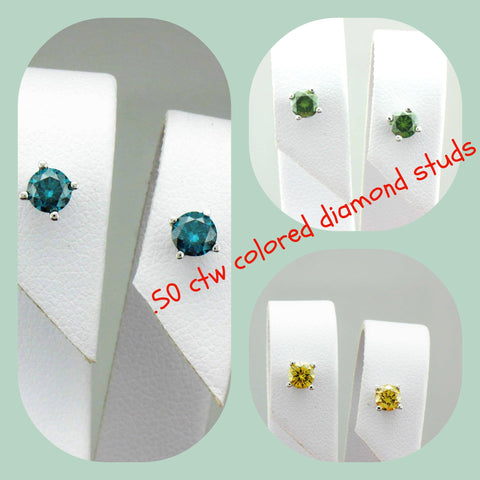
Colored Diamonds From The Laboratory
We have a line of colored diamond jewelry at Chimera.

The colored diamonds we sell (usually) are natural, white diamonds that have been changed into colored diamonds. There are three methods that can be used singly or in combination with each other depending on the color desired.
Electron Irradiation - a pulsed beam of electrons that will induce color into the diamonds is fired at them. The light absorbing pattern is changed and so is the color. Used alone, this process gives diamonds a blue or greenish blue color.
Annealment - To expand the range of colors, super heating them in an oxygen-free environment in temperatures 900 degrees and higher allows us to get other shades of color. The atomic structure of the diamonds rearrange, and a new palate of colors is possible.
High Pressure High Temperature (Hpht) - The HPHT process recreates the heat and pressure that creates diamonds initially in the Earth. Sophisticated machinery is programmed to accent conditions to get yellows, oranges, and greens.
There is a fourth method consisting of coating the diamond, which is used to create a truly pink color. The coating is done at the pavilion - the lower part of the diamond. This allows the color to shine through the entire diamond.

The first three treatments are more stable than the fourth. Diamonds that have been irradiated and/or annealed will not fade over time and they will wear like a normal diamond. The only caveat is that when being worked on by a jeweler, they need to be careful NOT to expose the diamond to heat in excess of 900 degrees which could occur when sizing a ring.
The HPHT method requires no caution of any kind.
The technology creating colored diamonds has moved forward tremendously in the last decade. When we first opened in 2002, treating diamonds was reserved for those very low on the clarity scale (I1 to I3) because the science was very in-exact as to the results. Sometimes they came out looking terrible. Blue ones could be all over the color spectrum and it was hard to create diamonds that were a good color match even when they were treated together.
Fast forward to the present day, and companies like Lotus Color can provide colored diamonds with better clarity (SI1-2) and with wonderful consistency. This makes it much easier to design and build colored diamond jewelry that is affordable and beautiful.

NATURAL COLORED DIAMONDS
They exist and they are extremely rare and costly. A 9.75 ct natural blue diamond (above) was auctioned in 2014 for 32.6 million dollars. Pink diamonds are found in Australia in very limited quantities and typically command prices in excess of what most of us can handle.
Typically a yellowish tint causes the price/value of a diamond to go down. That is true until the saturation of the yellow color reaches what GIA terms "Fancy" and then the price jumps up like a ROCKET!
Conclusion - creating colored diamonds in the lab is a wonderful way to make the long lasting beauty of colored diamond jewelry something that regular people can afford and appreciate. We are excited to offer colored diamond jewelry in our store and to you online.
Cliff has been selling diamonds for over 18 years now. He earned his Diamonds Graduate certification from GIA in 1998. Over the course of his career, he has sold clarity enhanced (CE) diamonds to a lot of people.
So what does "Clarity Enhanced" (CE) mean?
The imperfections in diamonds are called "inclusions" if they are inside the diamond and "blemishes" if they are on the outside. There is one particular type of inclusion that can be "repaired" using the clarity enhancement process: a feather. A feather is an inclusion that reaches the surface of the diamond. This picture shows a nice close up of a feather:
In the clarity enhancement process, a clear glass-like filler is put into the feather at an extremely high temperature and under very high pressure. (The industry guards the specifics, as you might imagine.)
Anyway, the material has the same reflective properties as a diamond, so you do not notice it unless you examine the diamond under magnification. It is also very noteworthy that the lab at GIA has weighed clarity enhanced diamonds before and after the treatment, and since the amount of material used is so minute, it adds no weight to the diamond. Very important since diamonds are sold by weight. GIA does NOT certify CE diamonds, but other labs do.
The CE process is NOT a miracle worker - you cannot take a I2 clarity diamond and turn it into a VS clarity stunner. Most times a diamond will move up one or possibly two notches on the clarity scale. That being said, what the CE translates to in terms of your pocketbook is that you can save about 30% by purchasing a CE gem.
Here are a couple of examples of the difference the CE process can make:

The top example has multiple feathers while the lower one has a very noticeable feather almost dead center on the diamond. The CE process renders them pretty much invisible. We say "pretty much" invisible because the process can be detected using magnification. Turning the CE diamond while examining it will produce a "flash" of color - most times a purple or orange or combination.
Here is an excellent photo of filled feathers demonstrating the purplish flash -

Any CE diamond we sell has a Lifetime Warranty on the process.
CE diamonds are not for everyone - but our attitude is that they are just another enhancement. Shoot, if you take a look at a diamond crystal the way they come out of the ground, you might not be impressed. You would probably walk right by one if you didn't know what you were looking for. It could be argued that cutting and polishing the diamond is a "clarity enhancement".
Here is a totally natural diamond crystal before cutting and polishing:
The ring below is an example of jewelry we made using clarity enhanced diamonds. The person who owned this ring saved about $2,000 by choosing a CE diamond. It was cut to ideal proportions and sparkles to beat the band!
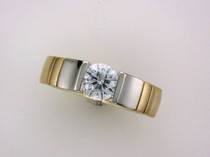
One last example: Two CE diamonds put into halo-style earrings. They weigh a total of 2.13 ctw and are accented by .22 ctw of diamonds. All in all, a gorgeous pair of earrings at a wonderful price, thanks to the clarity enhancement process. By using CE diamonds, this couple saved almost $3,000.00.
Hopefully you learned a little bit about CE diamonds. If you should have any questions, feel free to email or call Cliff - he loves to talk about diamonds.
















